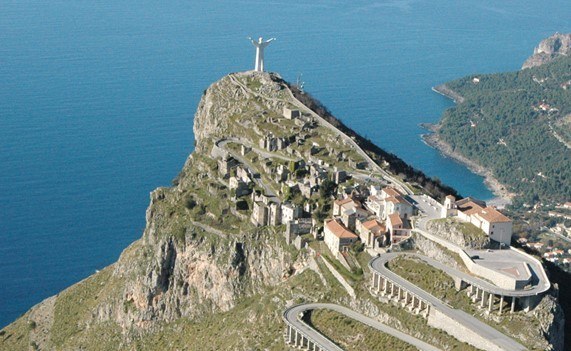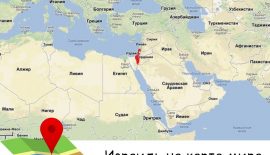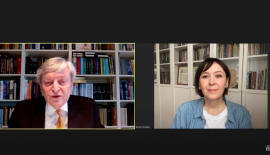Resurrection
Calabria – Italy is a wonderful place to be. The mountains, the villages, the seashore and the magnificent sunsets. The warmth and sometimes heat of this southern part of Italy during the daytime, and the cool breeze at night to cool you off. As in the whole of Italy Roman Catholicism is visibly present everywhere. Churches, crucifixes along the roads, statues of the Madonna. But on the high cliffs of Maratea there is another statue: Christ Risen. Like the huge statue of Christ at Rio the Janeiro – Brazil, this statue of over 20 metres high is visible from a long distance [Photo top]. But when one reaches the top of the cliff one sees that this Christ is not overlooking the sea, but his face and outstretched arms are looking land inwards. As if he is telling the people who approach him a message: “Don’t pass me by!” There is great danger behind my back! Let me please stop you! Because if you ignore me and pass me by, you will fall down the steep cliffs behind me and there will be no hope for you. You will smash against the rocks and die, and the people will find you hundreds of meters below me with a broken body like a ragged doll. Please don’t ignore my outstretched arms! I do want to save you from perishing! Isn’t that a beautiful message? The risen Christ wants to save us from eternal damnation. If only we would not ignore Him and His pierced outstretched arms.
Christ is Risen. That is not a fairy tale. Not something that one has to ‘believe’ by putting one’s mind out of action and one’s brains to a standstill and then jump into blind faith. No, the Bible is a book of realities. People like you and me reported about astonishing realities they experienced. And they were as flabbergasted as we would have been, if we had been in the same place at the same time as they were. The friends of Jesus were down-to-earth people. Fishermen – and Jewish. One does not take people like that for a ride. Or impose fancy stories upon them. But they were witnesses of astonishing facts, and they had a hard time to come to believe them. But facts one cannot deny, can one? If you have seen things with your own eyes, and heard things with your own ears, and if your hands could even touch the reality of it, there is no way one can deny the things one was a witness to.
John later writes: “…that which we have heard, which we have seen with our eyes, which we have looked at and our hands have touched – this we proclaim…we proclaim to you what we have seen and heard…we write this to make our joy complete…”(1John1:1-4) Because jóy it was, that finally prevailed, after all the astonishment and shaky feelings, doubts and hopes, and finally total conviction!
Because one cannot deny the facts, can one? John was there. He saw it and believed. In his gospel he writes in John 20:6-8: “Then Simon Peter who was behind him (John) arrived and went into the tomb, and he saw the strips of linen lying there, as well as the burial cloth that had been around Jesus head…Finally the other disciple (John), who had reached the tomb first, also went inside. He saw and believed…”
Now it has always puzzled me: what did John séé so that he believed? He saw the grave cloth, the strips of linen in which the body of Jesus had been buried. Joseph of Arimathea and Nicodemus had seen to that. They had even brought with them a mixture of myrrh and aloes, about 75 pounds, John 20:38-39! And they had buried the body of Jesus in the way the Jews were accustomed. They did not mummify the dead bodies as the Egyptians did. They left the corpse intact, but wrapped it into 2 pieces of linen: one for the head and one for the body, and simply wrapped the whole body in it while adding these oils, spices, anointments, herbs, etc. to prevent the bad smell, the stench, that eventually a decaying body would produce, and to make sure that instead of that the sweet odour of these spices would prevail. Then they laid the body wrapped up like this unto a couch of stone, hewn in the back wall of the cave in the rocks where the body would be put to rest. The body on the stone bench and the head on the stone ‘pillow’. Then a huge stone was rolled before the entrance of the cave to prevent grave-robbery, or animals to come in to scavenge the body.
After some time the oils, herbs, spices, aloes and myrrh dried up, giving the grave cloth and strips of linen in which the body and the head were buried a certain stiffness. It would have been very difficult to unwrap them and take the body out. So what did John see that made him believe? He must have seen the linen in its original form of the body – but without the body! Had he seen the strips of linen and the burial cloth thrown as a bundle somewhere in a corner of the cave, he would have thought: ‘what on earth has happened here?’ Even if he had found them neatly folded in a pile on the stone bench, he still would have thought: ‘what happened here, where is the body, who did this, et cetara?’ But if he saw the grave cloth in the form of the body – but without a body – the only logical conclusion he could have come to is this: the body somehow must have risen through the ‘burial-clothes’, because it is impossible to unwrap the body, then remove the body, and then put the stripes of linen and the burial cloth back into the form of the body. The 75 pounds of mixture of myrrh and aloes simply would make that impossible. So He must have risen. How? I don’t know, I cannot explain it, but it is the only logical explanation, John must have thought. He must have risen through the ‘burial-clothes’!
And if wrapped burial-clothes could not retain Him, neither could a stone rolled before the entrance. Neither could a room with the doors closed keep Him outside. So the stone was removed not to let Him out, but to let us in! In order that we could see with our own eyes and give testimony about these facts, incredible as they seem to be. John saw and believed. And he is telling us what he saw in order that we might believe. Jesus rose from the dead. The grave was empty. And only because the grave was empty, we start to understand the meaning of the cross.
Many Jews in those days were crucified by the Romans. Jesus was not the only one. Actually, when He was crucified two other Jews were crucified at the same time with Him, for various reasons. Murderers, thieves, revolutionaries, freedom-fighters who tried to free the land of Israel from the hated Roman occupation were crucified. Idealists, claiming to be Messiah to start an uprising, a revolt against the Romans. It was in those days the order of the day. And so they ended their lives as martyrs for the good cause. Unfortunately they failed and yet they were an inspiration for others. We cry about them and are inspired by their good example.
Even the famous Matthews Passion by Johan Sebastian Bach ends with it. We wish Jesus a good rest in the grave, that’s the final chorus. And the ‘Passion of Christ’, the movie by Mel Gibson ends in the same way. But was Jesus one of those unsuccessful martyrs for a good cause? The Bile says: No! The Bible claims that His death on the cross was a sacrifice, atonement for sin. But how can we be sure about that? Why was His death on the cross different from all the other crucifixions? Only if we look backwards from the empty grave, we start to understand the meaning of His death upon the cross.
How had ‘death’ entered into this world? Because of the sin of Adam. The Bible calls ‘death’ the wages of sin. When Adam fell, ‘sin’ entered this world. And because of ‘sin’ God decided to let ‘death’ enter into man’s life. He became a mortal being. And ‘death‘ entered not just into the life of man, but into the whole of creation. The whole of creation is suffering because of the sin of man.
So if God one-day would accept a sacrifice for sin, atonement for sin, redemption of sin, then the result must be that the consequence of sin – being ‘death’ – would simply disappear. And it happened. He crossed out ‘sin’ and therefore crossed out ‘death’ as well. Praise the Lord! The grave was empty. Death could not control Jesus anymore. So His death on the cross must have been the atonement for sin. The empty tomb is the proof of the validity of the cross. Free at last! And this is only the beginning. Those who put their faith in Jesus will rise in glory as well, with the same resurrected body that He had – and has, for that matter.
One-day the whole of creation will be made free as well. Paul writes about it in Romans 8:18-23. The Risen Christ, depicted as a statue high on the cliffs at Maratea in Calabria in the South of Italy is standing with outstretched arms and with hands in which the signs of the crucifixion are visible. It is telling without words everyone who is looking at it: ‘Don’t pass me by, because you will find a terrible end to your life. Let me save you from that horrible death.’ In the same way the Risen Christ is speaking in the Word of God to us all: “Let Me save you! I died for you on the cross in order that you might have life everlasting.”
John says it in these words: “For God so loved the world that He gave His only begotten Son, that whoever believes in Him shall not perish but have eternal life. For God did not send His Son into the world to condemn the world, but to save the world through Him.” (John 3:1617)
Are you saved by the blood of the Lamb that He shed as a sacrifice for your sin? Have you ever thanked Him for that what He did for you? Now is the time to do it in a personal way. It is between you and Him. Just speak to Him right now, ask forgiveness for your sins, ask Him to come into your life by the Holy Spirit and you are saved and on your way to a glorious future! To your own resurrection, because from now on heaven is your home, and His future is your future!









